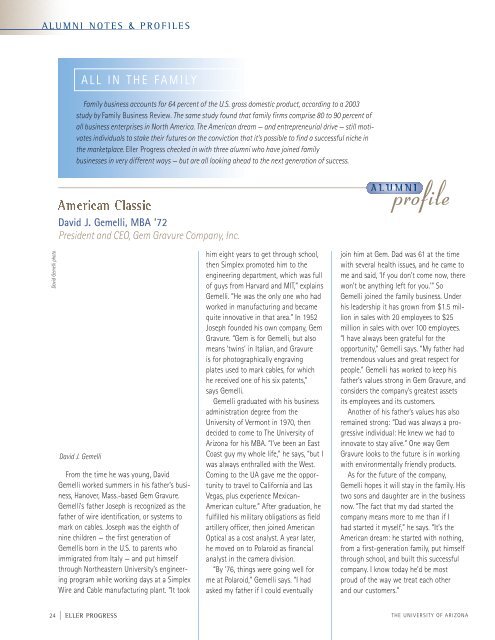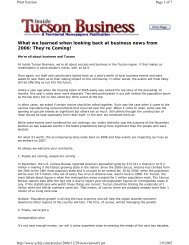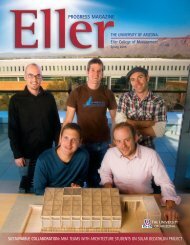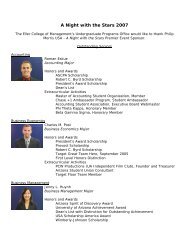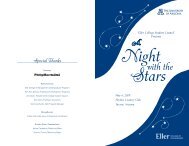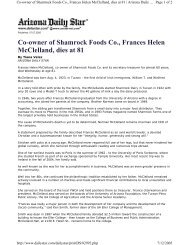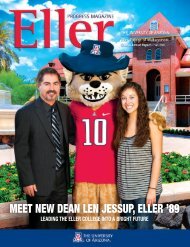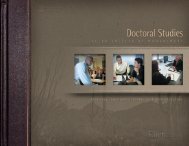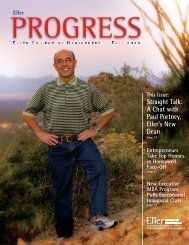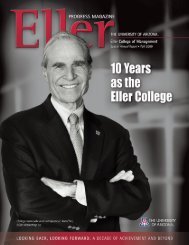Standing out from the crowd. - Eller College of Management ...
Standing out from the crowd. - Eller College of Management ...
Standing out from the crowd. - Eller College of Management ...
You also want an ePaper? Increase the reach of your titles
YUMPU automatically turns print PDFs into web optimized ePapers that Google loves.
ALUMNI NOTES &PROFILESDavid Gemelli photoAmerican ClassicDavid J. Gemelli, MBA ’72President and CEO, Gem Gravure Company, Inc.David J. GemelliALL IN THE FAMILYFamily business accounts for 64 percent <strong>of</strong> <strong>the</strong> U.S. gross domestic product, according to a 2003study by Family Business Review. The same study found that family firms comprise 80 to 90 percent <strong>of</strong>all business enterprises in North America. The American dream — and entrepreneurial drive — still motivatesindividuals to stake <strong>the</strong>ir futures on <strong>the</strong> conviction that it’s possible to find a successful niche in<strong>the</strong> marketplace. <strong>Eller</strong> Progress checked in with three alumni who have joined familybusinesses in very different ways — but are all looking ahead to <strong>the</strong> next generation <strong>of</strong> success.From <strong>the</strong> time he was young, DavidGemelli worked summers in his fa<strong>the</strong>r’s business,Hanover, Mass.-based Gem Gravure.Gemelli’s fa<strong>the</strong>r Joseph is recognized as <strong>the</strong>fa<strong>the</strong>r <strong>of</strong> wire identification, or systems tomark on cables. Joseph was <strong>the</strong> eighth <strong>of</strong>nine children — <strong>the</strong> first generation <strong>of</strong>Gemellis born in <strong>the</strong> U.S. to parents whoimmigrated <strong>from</strong> Italy — and put himselfthrough Nor<strong>the</strong>astern University’s engineeringprogram while working days at a SimplexWire and Cable manufacturing plant. “It tookhim eight years to get through school,<strong>the</strong>n Simplex promoted him to <strong>the</strong>engineering department, which was full<strong>of</strong> guys <strong>from</strong> Harvard and MIT,” explainsGemelli. “He was <strong>the</strong> only one who hadworked in manufacturing and becamequite innovative in that area.” In 1952Joseph founded his own company, GemGravure. “Gem is for Gemelli, but alsomeans ‘twins’ in Italian, and Gravureis for photographically engravingplates used to mark cables, for whichhe received one <strong>of</strong> his six patents,”says Gemelli.Gemelli graduated with his businessadministration degree <strong>from</strong> <strong>the</strong>University <strong>of</strong> Vermont in 1970, <strong>the</strong>ndecided to come to The University <strong>of</strong>Arizona for his MBA. “I’ve been an EastCoast guy my whole life,” he says, “but Iwas always enthralled with <strong>the</strong> West.Coming to <strong>the</strong> UA gave me <strong>the</strong> opportunityto travel to California and LasVegas, plus experience Mexican-American culture.” After graduation, hefulfilled his military obligations as fieldartillery <strong>of</strong>ficer, <strong>the</strong>n joined AmericanOptical as a cost analyst. A year later,he moved on to Polaroid as financialanalyst in <strong>the</strong> camera division.“By ’76, things were going well forme at Polaroid,” Gemelli says. “I hadasked my fa<strong>the</strong>r if I could eventuallyALUMNIpr<strong>of</strong>ilejoin him at Gem. Dad was 61 at <strong>the</strong> timewith several health issues, and he came tome and said, ‘If you don’t come now, <strong>the</strong>rewon’t be anything left for you.’” SoGemelli joined <strong>the</strong> family business. Underhis leadership it has grown <strong>from</strong> $1.5 millionin sales with 20 employees to $25million in sales with over 100 employees.“I have always been grateful for <strong>the</strong>opportunity,” Gemelli says. “My fa<strong>the</strong>r hadtremendous values and great respect forpeople.” Gemelli has worked to keep hisfa<strong>the</strong>r’s values strong in Gem Gravure, andconsiders <strong>the</strong> company’s greatest assetsits employees and its customers.Ano<strong>the</strong>r <strong>of</strong> his fa<strong>the</strong>r’s values has alsoremained strong: “Dad was always a progressiveindividual: He knew we had toinnovate to stay alive.” One way GemGravure looks to <strong>the</strong> future is in workingwith environmentally friendly products.As for <strong>the</strong> future <strong>of</strong> <strong>the</strong> company,Gemelli hopes it will stay in <strong>the</strong> family. Histwo sons and daughter are in <strong>the</strong> businessnow. “The fact that my dad started <strong>the</strong>company means more to me than if Ihad started it myself,” he says. “It’s <strong>the</strong>American dream: he started with nothing,<strong>from</strong> a first-generation family, put himselfthrough school, and built this successfulcompany. I know today he’d be mostproud <strong>of</strong> <strong>the</strong> way we treat each o<strong>the</strong>rand our customers.”Staying True to <strong>the</strong> VisionSarah Brown Smallhouse, MBA ’88President, Thomas R. Brown Family FoundationSarah Brown Smallhouse grew up observing <strong>the</strong> familybusiness — her fa<strong>the</strong>r Thomas c<strong>of</strong>ounded Burr-BrownResearch Corporation, which was purchased by TexasInstruments in 2000 — but, she says, “It was definitely not aforegone conclusion that I’d work for Burr-Brown.”“Our family operated in such a way that we were veryengaged,” she continues. “My sister Mary and I attendedboard meetings, but we weren’t being groomed to takeover.” Smallhouse attended <strong>the</strong> University <strong>of</strong> Washingtonand earned her bachelor’s degree in economics, but wasinterested in natural resources. She returned to Arizona andbegan work with S<strong>out</strong>hern Arizona Water ResourcesAssociation, a group formed to promote completion <strong>of</strong> <strong>the</strong>Central Arizona Project to S<strong>out</strong>hern Arizona. Then, she says,“A couple <strong>of</strong> <strong>the</strong> board members who were attorneysapproached me ab<strong>out</strong> working with <strong>the</strong>ir firm and I accepteda position as a paralegal in water law.”Smallhouse decided to go back to school a year and a halflater. “I wanted something versatile,” she says, “so it wasei<strong>the</strong>r going to be a JD or an MBA.” She chose <strong>the</strong> <strong>Eller</strong> MBAand graduated in 1988, <strong>the</strong>n launched <strong>the</strong> business shedeveloped in <strong>the</strong> entrepreneurship program. “It was basedon passive evaporative cooling, a technology developed in<strong>the</strong> UA Environmental Research Lab,” she says. Her companyworked with <strong>the</strong> U.S. Department <strong>of</strong> Transportation in earlyapplication <strong>of</strong> <strong>the</strong> technology: towers designed to createcool downward air flow. The first application was at reststop tourist kiosks, so visitors could read information undera cool breeze. They closed <strong>the</strong> company because <strong>the</strong> technologywas too simple and widely published to protect. Theearly towers were all custom-built, and too expensive for<strong>the</strong> broader market.The Smallhouse family relocated to Alamos, Sonora,Mexico, where Smallhouse opened a real estate company. “Ihad some legal background and was fluent in both Englishand Spanish, so it worked well,” she says. She operated <strong>the</strong>company for ab<strong>out</strong> five years. “It was an interesting thing,because <strong>the</strong> market was so small in Alamos,” she says. “Itwas a very international <strong>crowd</strong> <strong>of</strong> people. There was a hugeexpatriate community, and it was a rich experience.”Thomas R. Brown Family Foundation photoALUMNIpr<strong>of</strong>ileSarah Brown Smallhouse (left front) and her sister Mary Brownwith Brown Foundation Board members Gerry Swanson,John Carter, and Michael Hard.In <strong>the</strong> late 1990s, her family established <strong>the</strong> Thomas R. BrownFoundation. “It was part <strong>of</strong> <strong>the</strong> overall family plan for giving backand developing a strategic vehicle for family philanthropy,”Smallhouse explains. “We tend to focus on gifts that are transformative,that help organizations do things <strong>the</strong>y would notordinarily be able to do.” In addition to funding initiatives at <strong>the</strong><strong>Eller</strong> <strong>College</strong> and <strong>the</strong> <strong>College</strong> <strong>of</strong> Engineering, <strong>the</strong> Foundation hassupported a Tucson Medical Center-Pima Community <strong>College</strong>partnership, <strong>the</strong> Critical Path Institute, and many o<strong>the</strong>rs.“We got advice early on to think long-term, to think ab<strong>out</strong>ways to help people be more capable on <strong>the</strong>ir own,” she says.“But we try not to pick something so long-term that we’ll neversee <strong>the</strong> results, or so big, that we will never see <strong>the</strong>m reached.”Those goals dovetail nicely with what her fa<strong>the</strong>r envisioned forBurr-Brown. “Our family’s situation exists only because <strong>of</strong> Burr-Brown,” she says. “And Burr-Brown was never a quest to makemoney. It was a quest to make things that benefit mankind. Wetry to stay true to that purpose in <strong>the</strong> philanthropic end <strong>of</strong>things and constantly remind people <strong>of</strong> my fa<strong>the</strong>r’s successstory. We want to provide <strong>the</strong> foundation for people to repeatthat story.”24 ELLER PROGRESS THE UNIVERSITY OF ARIZONAWWW.ELLER.ARIZONA.EDUFALL 2008 25


